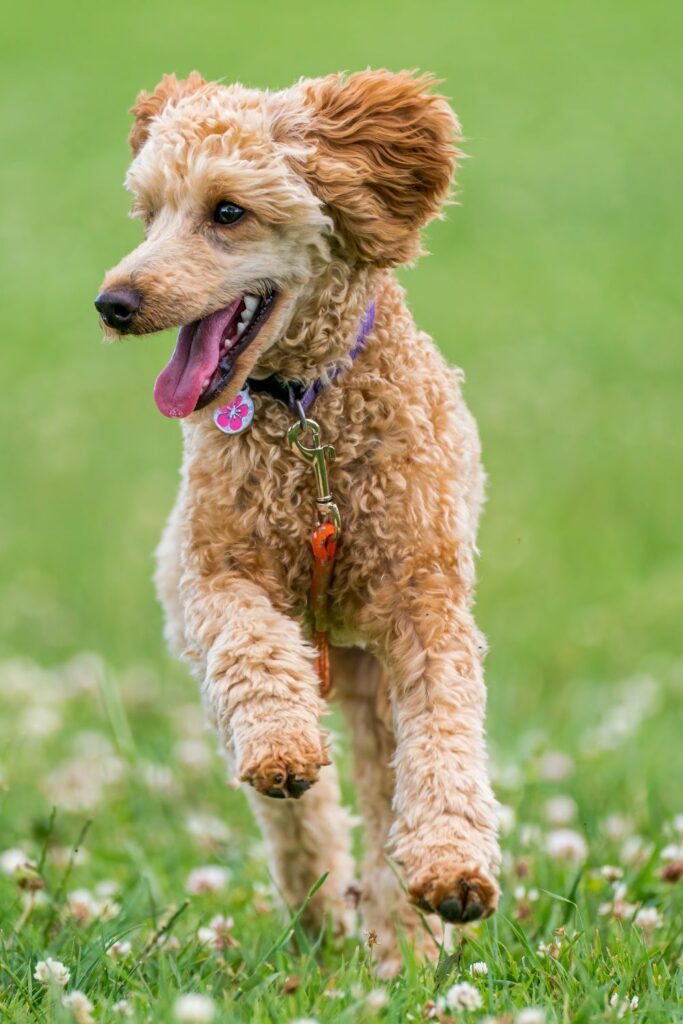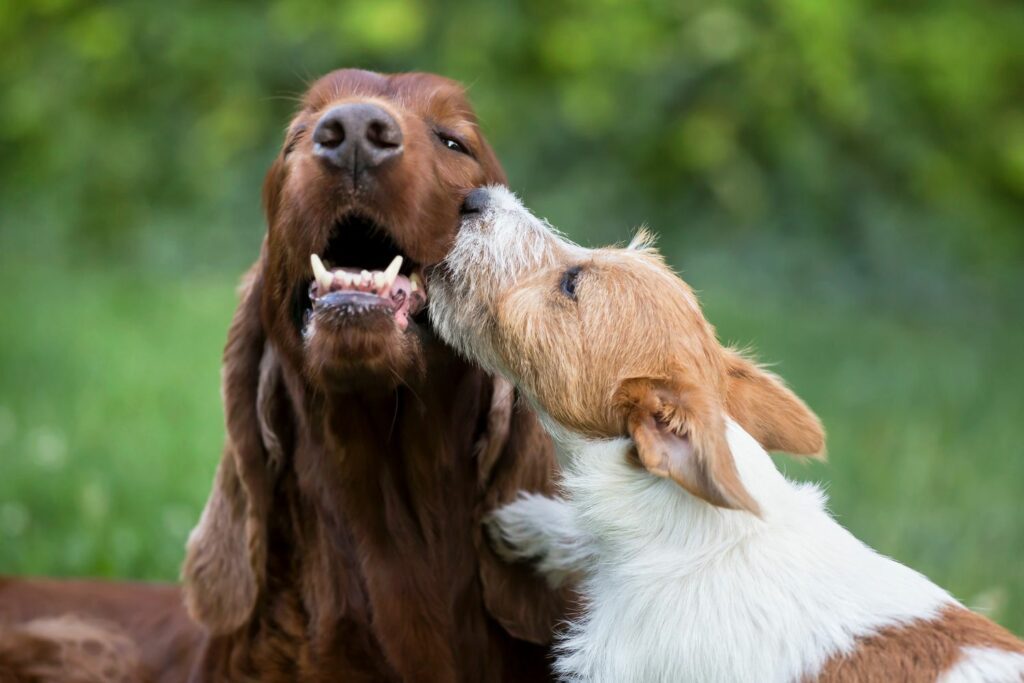How to Tell if Your Dog is Happy
 Darren Buser
Darren Buser
As devoted pet owners, we often wonder what’s going on in our furry friends’ minds. Understanding our dogs’ emotional states ensures their well-being and happiness. But how can we tell if our beloved canine companions are truly happy? Unlike us, dogs can’t verbalize their feelings, making us need to learn to read their unique language of joy.
In this article, we’ll explore the various signs that indicate your dog is in good spirits, from the wag of their tail to the sparkle in their eyes. Knowing these signs not only deepens the bond we share with our pets but also helps us provide the best care possible, ensuring they lead a fulfilled and joyful life. Happy dogs are healthy dogs. So, let’s dive into the world of wagging tails and bright eyes to understand the joy of our four-legged family members, expressed through a happy dog’s whole body.

Physical Signs of a Happy Dog
One of the most delightful aspects of being a dog owner is witnessing the unbridled joy our pets exhibit. But how can we be sure these displays are signs of happiness? Fortunately, dogs often wear their hearts on their sleeves—or more accurately, on their tails and in their posture.
Tail Wagging: A wagging tail is the quintessential sign of a happy dog. However, it’s important to note that tail wagging can convey various emotions. A relaxed, gently wagging tail usually signifies contentment, while a stiff, rapid wag might indicate excitement or even agitation. Observing your dog’s context and overall body language is key to understanding their emotional state.
Relaxed Posture: A content dog often has a relaxed body language and posture. Their muscles are not tense, they have a relaxed tail position and their body language is loose and easy. This relaxed state can extend to their facial expressions as well—soft eyes and a slightly open mouth, often described as a ‘doggy smile,’ are telltale signs of a happy dog.

Floppy Ears: A happy dog’s ears are often in a natural, relaxed position. The exact position can vary depending on the breed and the individual dog, but generally, the ears will not be pinned back against the head or pricked forward sharply, which can indicate fear or alertness, respectively.
Bright, Alert Eyes: Happiness in dogs is also reflected in their eyes. Bright, alert eyes, often accompanied by a focused yet soft gaze, indicate that your dog is engaged and comfortable. This contrasts the narrowed or averted eyes that might signal stress or discomfort.
Behavioural Indicators of Happiness in Dogs
While physical signs provide clear insights into a dog’s emotional state, understanding their behaviour offers an even deeper glimpse into their world of happiness. Several key indicators often characterize a happy dog’s body language and behaviour:
Playful Behavior: One of the most obvious signs of a comfortable dog is their playfulness. Quite often, happy dogs tend to engage in games, whether it’s chasing a ball, playing with toys, or playful interactions with their human companions or other pets. A happy dog reacts pleasantly and playfully to those around them. This playfulness is a sign of their good spirits and overall well-being.
Good Appetite: A healthy appetite is another indicator of dog happiness. When dogs are content and stress-free, they usually show a keen interest in their meals. However, it’s important to balance their diet and avoid overfeeding, as obesity can lead to health issues. As pet owners, ensuring our dogs receive nutritious and balanced meals, like those provided by Nala Health, contributes significantly to their happiness. An unhealthy diet could make for an unhappy dog, and that is the last thing anyone would want for our canine companion.

Curiosity and Interest in Surroundings: A cheerful dog is often a curious one, taking an interest in their surroundings and exploring their environment. This curiosity manifests as sniffing around, exploring new areas during walks, or showing interest in new objects or people. It reflects their comfort and confidence in their environment.
Sociable and Enjoying Interaction: Lastly, a happy dog usually enjoys social interaction. This could be with their human family, dogs, or pets. They may initiate play, seek out cuddles, or simply enjoy being in the company of others. However, it’s important to recognize that each dog and dog breed has its own personality, and some may naturally be more reserved. The key is noticing what’s normal for your dog and observing any changes.
Vocalizations and Sounds: Understanding Your Dog’s Happy Noises
Dogs communicate a lot through the sounds they make, and these vocalizations can be a window into their emotional world. Understanding what different sounds mean can help you better gauge your dog’s happiness.
Happy Sounds: Contented dogs often make soft, gentle sounds. These can range from quiet whines and sighs when they are relaxed to playful barks and growls during a game. A happy bark is typically lower in pitch and seems to invite interaction, as opposed to the sharp, persistent barks that might indicate distress or alertness.
Contented Sighs and Soft Grunts: When your dog settles down for a rest and lets out a deep sigh, it’s often a sign of contentment. These sighs indicate that they feel safe and relaxed in their environment. Soft grunts, especially when being petted or cuddled, are also expressions of happiness and comfort.
Understanding the Context: It’s important to understand the context in which these sounds are made. The same sound can convey different emotions depending on the situation. For example, a bark during play is very different from a bark at an unfamiliar sound. Observing the circumstances and combining this with knowledge of your dog’s usual behavior will help you understand what they are feeling.

The Importance of a Healthy Routine in a Dog’s Happiness
While understanding the signs of happiness in dogs is crucial, it’s equally important to know how to foster this contentment. A significant part of a dog’s happiness stems from a consistent and healthy routine.
Regular Exercise: Regular physical activity is vital for a dog’s mental and physical health. Exercise helps to burn off excess energy, reduces boredom, and keeps them fit. Whether it’s daily walks, playtime in the park, or agility training, you can make your dog happy by keeping them active.
Balanced Diet: Just like humans, the diet of a dog greatly impacts their mood and overall health. A balanced diet that meets all their nutritional needs contributes to their well-being. Nala Health’s range of nutritional dog food can play a key role in ensuring your dog receives all the necessary nutrients for a happy and healthy life.
Mental Stimulation: Mental stimulation is often overlooked but is just as important as physical exercise. Interactive games, training sessions, and toys that challenge their minds keep dogs engaged and satisfied. A mentally stimulated dog is less likely to exhibit destructive behaviors, which are often signs of boredom or stress.

Regular Health Check-Ups: Regular visits to the vet for check-ups ensure that any health issues are caught and treated early. A healthy dog is a happy dog, and preventive health care is key to maintaining their happiness.
Recognizing Changes in Behavior & Body Language: Signs to Watch For
While it’s important to understand the signs of a cheerful dog, it’s equally crucial to be aware of changes in their behaviour. These changes can sometimes be the first indicators of underlying health or emotional issues.
Sudden Lack of Interest in Activities: If your dog suddenly shows less interest in activities they usually enjoy, like playing or going for walks, it might be a sign that something is amiss. This change can indicate physical discomfort, emotional distress, or even boredom.
Changes in Appetite: A significant decrease or increase in appetite can signify stress, anxiety, or health issues. While occasional fluctuations are normal, consistent changes in eating habits warrant attention and possibly a veterinary consultation.
Unusual Aggression or Withdrawal: If your dog, who is usually sociable and friendly, starts showing aggression or becomes unusually withdrawn, this could be a sign of discomfort or illness. Changes in social behaviour are often a clear indicator that your dog is not feeling their best.

Sleep Pattern Changes: Excessive sleep or restlessness and inability to sleep can be signs of trouble. Like in humans, sleep disturbances in dogs can be related to various health or emotional issues.
Excessive Grooming or Licking: Dogs sometimes lick or groom themselves excessively when in pain or feeling anxious. This behaviour can lead to skin issues and should be addressed promptly.
Conclusion
Understanding the signs of happiness in our dogs is a journey filled with tail wags, playful barks, and loving gazes. By learning to read these signs, we deepen our bond with our canine companions, ensuring their emotional and physical well-being.
From the wag of a tail to a contented sigh, the signs of a happy dog are there for us to see and understand. It’s through our daily interactions, observations, and care that we can ensure our furry friends lead joyous lives. And when in doubt, seeking the advice of a veterinarian or a pet care specialist is always a wise step.
At Nala Health, we’re committed to helping you provide the best care for your pet, ensuring that their tails keep wagging as they enjoy a happy life. Explore our blog for more insights, tips, and advice on pet care, and join us in celebrating the joyful journey of pet ownership.

